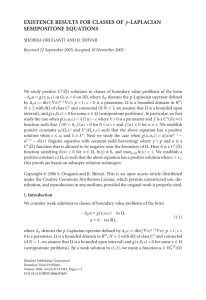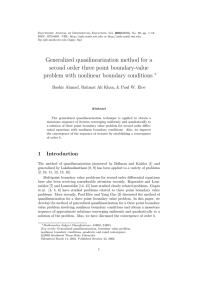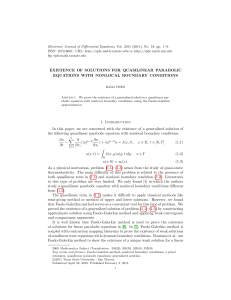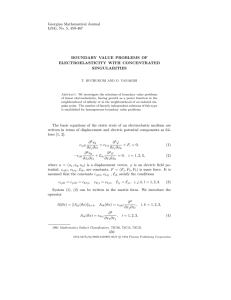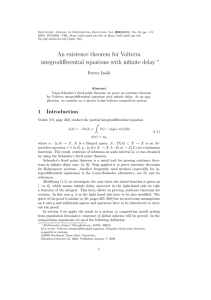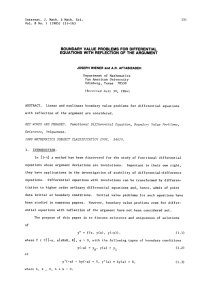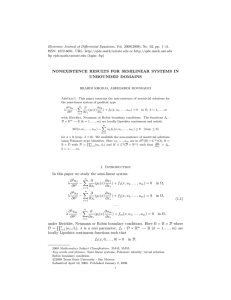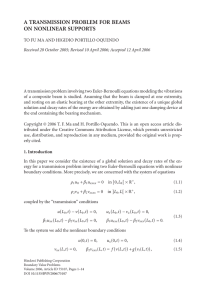Document 10817460
advertisement
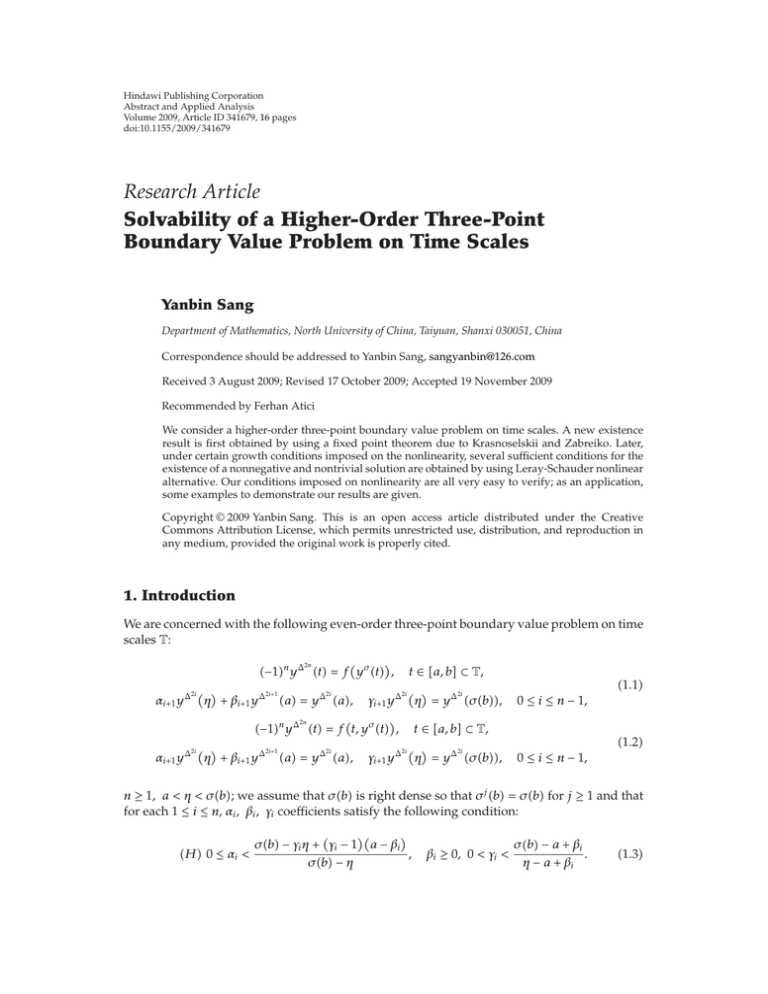
Hindawi Publishing Corporation
Abstract and Applied Analysis
Volume 2009, Article ID 341679, 16 pages
doi:10.1155/2009/341679
Research Article
Solvability of a Higher-Order Three-Point
Boundary Value Problem on Time Scales
Yanbin Sang
Department of Mathematics, North University of China, Taiyuan, Shanxi 030051, China
Correspondence should be addressed to Yanbin Sang, sangyanbin@126.com
Received 3 August 2009; Revised 17 October 2009; Accepted 19 November 2009
Recommended by Ferhan Atici
We consider a higher-order three-point boundary value problem on time scales. A new existence
result is first obtained by using a fixed point theorem due to Krasnoselskii and Zabreiko. Later,
under certain growth conditions imposed on the nonlinearity, several sufficient conditions for the
existence of a nonnegative and nontrivial solution are obtained by using Leray-Schauder nonlinear
alternative. Our conditions imposed on nonlinearity are all very easy to verify; as an application,
some examples to demonstrate our results are given.
Copyright q 2009 Yanbin Sang. This is an open access article distributed under the Creative
Commons Attribution License, which permits unrestricted use, distribution, and reproduction in
any medium, provided the original work is properly cited.
1. Introduction
We are concerned with the following even-order three-point boundary value problem on time
scales T:
2n
−1n yΔ t f yσ t ,
2i 2i1
2i
αi1 yΔ η βi1 yΔ a yΔ a,
t ∈ a, b ⊂ T,
2i 2i
γi1 yΔ η yΔ σb,
2n
−1n yΔ t f t, yσ t ,
2i 2i1
2i
αi1 yΔ η βi1 yΔ a yΔ a,
0 ≤ i ≤ n − 1,
t ∈ a, b ⊂ T,
2i 2i
γi1 yΔ η yΔ σb,
0 ≤ i ≤ n − 1,
1.1
1.2
n ≥ 1, a < η < σb; we assume that σb is right dense so that σ j b σb for j ≥ 1 and that
for each 1 ≤ i ≤ n, αi , βi , γi coefficients satisfy the following condition:
σb − γi η γi − 1 a − βi
,
H 0 ≤ αi <
σb − η
βi ≥ 0, 0 < γi <
σb − a βi
.
η − a βi
1.3
2
Abstract and Applied Analysis
Throughout this paper, we let T be any time scale and let a, b be a subset of T such
that a, b {t ∈ T : a ≤ t ≤ b}. Some preliminary definitions and theorems on time scales can
be found in 1–5 which are excellent references for the calculus of time scales.
In recent years, there is much attention paid to the existence of positive solution
for second-order multipoint and higher-order two-point boundary value problems on time
scales; for details, see 6–16 and references therein. However, to the best of our knowledge,
there are not many results concerning multipoint boundary value problems of higher-order
on time scales; we refer the readers to 17–20 for some recent results.
We would like to mention some results of Anderson and Avery 17, Anderson and
Karaca 18, Han and Liu 19, and Yaslan 20. In 17, Anderson and Avery studied the
following even-order three-point BVP:
n
−1n xΔ∇ t λhtfxt,
i
xΔ∇ a 0,
i
t ∈ a, c ⊂ T,
i
xΔ∇ c βxΔ∇ b,
0 ≤ i ≤ n − 1.
1.4
They have studied the existence of at least one positive solution to the BVP 1.4 using the
functional-type cone expansion-compression fixed point theorem.
In 18, Anderson and Karaca were concerned with the dynamic three-point boundary
2n
value problem 1.2 and the eigenvalue problem −1n yΔ t λft, yσ t with the same
boundary conditions where λ is a positive parameter. Existence results of bounded solutions
of a noneigenvalue problem were first established as a result of the Schauder fixed point
theorem. Second, the monotone method was discussed to ensure the existence of solutions
of the BVP 1.2. Third, they established criteria for the existence of at least one positive
solution of the eigenvalue problem by using the Krasnosel’skii fixed point theorem. Later,
they investigated the existence of at least two positive solutions of the BVP 1.2 by using the
Avery-Henderson fixed point theorem.
In 19, Han and Liu studied the existence and uniqueness of nontrivial solution for
the following third-order p-Laplacian m-point eigenvalue problems on time scales:
∇
λf t, ut, uΔ t 0,
φp uΔ∇
αu0 − βuΔ 0 0,
uT t ∈ 0, T ,
1.5
m−2
ai uξi ,
uΔ∇ 0 0,
i1
where φp s is p-Laplacian operator, that is, φp s |s|p−2 s, p > 1, λ > 0 is a parameter, and
0 < ξ1 < · · · < ξm−2 < ρT . They obtained several sufficient conditions of the existence and
uniqueness of nontrivial solution of the BVP 1.5 when λ is in some interval. Their approach
was based on the Leray-Schauder nonlinear alternative.
Very recently, Yaslan 20 investigated the existence of solutions to the nonlinear evenorder three-point boundary value problem on time scales T:
2n
−1n yΔ t f t, yσt ,
yΔ
2i1
t1 0,
αyΔ σt3 βyΔ
2i
t ∈ t1 , t3 ⊂ T,
2i1
σt3 yΔ
2i1
t2 1.6
Abstract and Applied Analysis
3
for 0 ≤ i ≤ n − 1, where α > 0 and β > 1 are given constants. On the one hand, the author
established criteria for the existence of at least one solution and of at least one positive
solution for the BVP 1.6 by using the Schauder fixed point theorem and Krasnosel’skii
fixed point theorem, respectively. On the other hand, the author investigated the existence of
multiple positive solutions to the BVP 1.6 by using Avery-Henderson fixed point theorem
and Leggett-Williams fixed point theorem.
In this paper, motivated by 21, firstly, a new existence result for 1.1 is obtained by
using a fixed point theorem, which is due to KrasnoseÍskı̆ and Zabreı̆ko 22. Particularly,
f may not be sublinear. Secondly, some simple criteria for the existence of a nonnegative
solution of the BVP 1.2 are established by using Leray-Schauder nonlinear alternative.
Thirdly, we investigate the existence of a nontrivial solution of the BVP 1.2; our approach
is also based on the application of Leray-Schauder nonlinear alternative. Particularly, we do
not require any monotonicity and nonnegativity on f. Our conditions imposed on f are all
very easy to verify; our method is motivated by 1, 21, 23, 24.
2. Preliminaries
To state and prove the main results of this paper, we need the following lemmas.
Lemma 2.1 see 18. For 1 ≤ i ≤ n, let Gi t, s be Green’s function for the following boundary
value problem:
−yΔ t 0,
2
t ∈ a, b ⊂ T,
αi y η βi yΔ a ya,
γi y η yσb,
2.1
and let di γi − 1a − βi 1 − αi σb ηαi − γi . Then, for 1 ≤ i ≤ n,
Gi t, s ⎧
⎨Gi1 t, s,
a ≤ s ≤ η,
⎩G t, s,
i2
η < s ≤ b,
2.2
where
⎧
σs ≤ t,
1 ⎨ γi t − η σb − t σs βi − a ,
Gi1 t, s di ⎩ γ σs − η σb − σs t β − a α η − σb t − σs, t ≤ s,
i
i
i
⎧
1 ⎨ σs1 − αi αi η βi − a σb − t γi η − a βi t − σs, σs ≤ t,
Gi2 t, s di ⎩
t1 − α α η β − aσb − σs,
t ≤ s.
i
i
i
2.3
Lemma 2.2 see 18. Under condition H, for 1 ≤ i ≤ n, Green’s function Gi t, s in 2.2
possesses the following property:
Gi t, s > 0,
t, s ∈ a, σb × a, b.
2.4
4
Abstract and Applied Analysis
Lemma 2.3 see 18. Assume that H holds. Then, for 1 ≤ i ≤ n, Green’s function Gi t, s in
2.2 satisfies
1
η−aβi σb−σs ,
Gi t, s ≤ max Gi a, s, Gi σs, s,
di
t, s ∈ a, σb×a, b, 0 < γi ≤ 1,
Gi t, s ≤ max{Gi σb, s, Gi σs, s},
t, s ∈ a, σb × a, b, 1 < γi <
σb − a βi
.
η − a βi
2.5
Lemma 2.4 see 18. Assume that condition H is satisfied. For G as in 2.2, take H1 t, s :
G1 t, s and recursively define
Hj t, s σb
2.6
Hj−1 t, rGj r, sΔr
a
for 2 ≤ j ≤ n. Then Hn t, s is Green’s function for the homogeneous problem:
−1n yΔ t 0,
2n
2i 2i1
2i
αi1 yΔ η βi1 yΔ a yΔ a,
t ∈ a, b ⊂ T,
2i 2i
γi1 yΔ η yΔ σb,
Lemma 2.5 see 18. Assume that H holds. If one defines K Hn t, s in Lemma 2.4 satisfies the following inequalities:
0 ≤ Hn t, s ≤ KGn ·, s,
n−1
0 ≤ i ≤ n − 1.
j1 Kj ,
2.7
then the Green function
t, s ∈ a, σb × a, b,
2.8
where
Kj σb
Gj ·, sΔs > 0,
1 ≤ j ≤ n.
2.9
a
Lemma 2.6 see 22. LetX be a Banach space and let F : X → X be completely continuous. If
there exists a bounded and linear operator A : X → X such that 1 is not an eigenvalue of A and
lim
u → ∞
Fu − Au
0,
u
2.10
then F has a fixed point in X.
Lemma 2.7 see 25. Let X be a real Banach space, let Ω be a bounded open subset of X, 0 ∈ Ω,
and let F : Ω → X be a completely continuous operator. Then either there exist x ∈ ∂Ω, λ > 1 such
that Fx λx or there exists a fixed point x∗ ∈ Ω.
Abstract and Applied Analysis
5
Suppose that B denotes the Banach space Ca, σb with the norm y
supt∈a,σb |yt|.
3. Existence Results
In this section, we apply Lemmas 2.6 and 2.7 to establish some existence criteria for 1.1 and
1.2.
Theorem 3.1. Suppose that condition H holds, and f
lims → ∞ fs/s m. If
: R
→
R is continuous with
⎤−1
⎡
n
|m| < d ⎣ Kj ⎦ ,
3.1
j1
then the BVP 1.1 has a solution y∗ , and y∗ / 0 when f0 / 0.
Proof. Define the integral operator F : B → B by
Fyt σb
Hn t, sf yσ s Δs
3.2
a
for t ∈ a, σb. Obviously, the solutions of the BVP 1.1 are the fixed points of operator F.
From the proof of Theorem 3.1 of 18, we can know that F : B → B is completely continuous.
In order to apply Lemma 2.6, we consider the following BVP:
−1n yΔ t myσ t,
2n
2i 2i1
2i
αi1 yΔ η βi1 yΔ a yΔ a,
t ∈ a, b ⊂ T,
2i 2i
γi1 yΔ η yΔ σb,
0 ≤ i ≤ n − 1.
3.3
Define the integral operator A : B → B by
Ayt m
σb
Hn t, syσ sΔs
3.4
a
for t ∈ a, σb. Then it is easy to check that A : B → B is completely continuous so
bounded linear operator and that solutions of the BVP 3.3 are the fixed points of operator
A and conversely.
First, we claim that 1 is not an eigenvalue of A.
In fact, if m 0, then it is obvious that the BVP 3.3 has no nontrivial solution.
6
Abstract and Applied Analysis
If m /
0 and the BVP 3.3 has a nontrivial solution y, then y > 0, and so
y Ay
σb
σ
sup m
Hn t, sy sΔs
a
t∈a,σb
σb
σ
|m| sup Hn t, sy sΔs
a
t∈a,σb
≤ |m|
σb
KGn ·, syσ sΔs
3.5
a
⎛
⎞
n
≤ |m|⎝ Kj ⎠y
j1
<d·
1
y y,
d
which is impossible. So, 1 is not an eigenvalue of A.
Next, we will show that
F y − A y lim
0.
y
y → ∞
3.6
In fact, for any > 0, since lims → ∞ fs/s m, there must exist a number Y1 > 0 such that
fs − ms < |s|,
|s| > Y1 .
3.7
Let
M maxfs.
|s|≤Y1
3.8
Then for any y ∈ B and y > Y Y > 0, we distinguish the following two cases.
Case 1 Y < Y1 . In this case, choose Y such that
M |m|Y1
< .
Y
3.9
Thus, when s ∈ a, σb and |yσ s| ≤ Y1 , we have
σ f y s − myσ s ≤ f yσ s |m|yσ s ≤ M |m|Y1 < Y < y,
3.10
Abstract and Applied Analysis
7
which together with 3.7 implies that
y > Y.
σ f y s − myσ s < y,
3.11
Case 2 Y ≥ Y1 . In this case, when s ∈ a, σb, from 3.7, we see that
σ f y s − myσ s < yσ s ≤ y.
3.12
Thus, we can deduce from 3.11 and 3.12 that for any y ∈ B and y > Y
σ f y s − myσ s < y,
∀s ∈ a, σb.
3.13
From 3.13, we have
F y − A y ≤
σb
σ σ
sup Hn t, s f y s − my s Δs
a
t∈a,σb
σb
sup
Hn t, sf yσ s − myσ sΔs
t∈a,σb a
⎛
⎞
n
≤ y⎝ Kj ⎠
3.14
j1
y.
d
that is to say,
F y − A y lim
0.
y
y → ∞
3.15
Then, it follows from Lemma 2.6 that F has a fixed point y∗ ∈ B. In other words, y∗ is a
solution of the BVP 1.1. Moreover, we can assert that y∗ is nontrivial when f0 / 0. In fact,
if f0 /
0, then
f0,
−1n 0Δ 0 /
2n
3.16
that is, 0 is not a solution of the BVP 1.1.
Corollary 3.2. Assume that condition H holds, and f : 0, ∞ → 0, ∞ is continuous with
lims → ∞ fs/s 0. Then the BVP 1.1 has a nonnegative solution.
8
Abstract and Applied Analysis
Proof. Let
f ∗ s ⎧
⎨fs,
s ≥ 0,
⎩f−s,
3.17
s < 0,
then f ∗ : R → 0, ∞ is continuous, and from lims → ∞ fs/s 0, we know that
f ∗ s
0.
s → ∞ s
3.18
lim
Consider the following BVP:
2n
−1n yΔ t f ∗ yσ t ,
2i 2i1
2i
αi1 yΔ η βi1 yΔ a yΔ a,
t ∈ a, b ⊂ T,
2i 2i
γi1 yΔ η yΔ σb,
0 ≤ i ≤ n − 1.
3.19
It follows from Theorem 3.1 that the BVP 3.19 has a solution y∗ , that is,
Δ2n
σ t f ∗ y∗ t ,
−1n y∗
Δ2i
Δ2i Δ2i1
η βi1 y∗
αi1 y∗
a y∗
a,
t ∈ a, b ⊂ T,
Δ2i ∗ Δ2i
γi1 y∗
η y
σb,
0 ≤ i ≤ n − 1.
3.20
Since Hn t, s and f ∗ are nonnegative, we can get that y∗ ≥ 0 on a, σb. Consequently, from
the definition of f ∗ , we have
σ Δ2n
t f y∗ t ,
−1n y∗
t ∈ a, b ⊂ T.
3.21
It follows from the boundary conditions of 3.20 and 3.21 that y∗ is a nonnegative solution
of the BVP 1.1.
Remark 3.3. In Corollary 3.2, we only need that lims → ∞ fs/s 0. Thus, f may not be
sublinear.
Theorem 3.4. Assume that condition H holds, and
f : a, σb × 0, ∞ −→ 0, ∞ is continuous with
ft, u > 0 for t, u ∈ a, σb × 0, ∞,
ft, u ≤ ϕtgu on a, σb × 0, ∞ with g ≥ 0 continuous,
and nondecreasing on 0, ∞ and ϕ : a, σb → 0, ∞ continuous
∃r > 0 with r > gr
σb
a
ϕsKGn ·, sΔs,
3.22
3.23
3.24
Abstract and Applied Analysis
9
where K and Gn ·, s are defined in Lemmas 2.5 and 2.1, respectively. Then the BVP 1.2 has a
nonnegative solution y1 with y1 < r.
Proof. We consider the following boundary value problem:
2n
−1n yΔ t λf ∗ t, yσ t ,
2i 2i1
2i
αi1 yΔ η βi1 yΔ a yΔ a,
t ∈ a, b ⊂ T,
2i 2i
γi1 yΔ η yΔ σb,
0 ≤ i ≤ n − 1.
3.25
where 0 < λ < 1, and
f ∗ t, u ⎧
⎨ft, u,
u ≥ 0,
⎩ft, 0,
u < 0.
3.26
Let y be any solution of 3.25. Then
σb
yt λ
Hn t, sf ∗ s, yσ s Δs
3.27
a
for t ∈ a, σb. We note that yt ≥ 0 for t ∈ a, σb. It follows from condition 3.23 in
Theorem 3.4 that for t ∈ a, σb
yt ≤
σb
Hn t, sϕsg yσ s Δs
a
σb
≤ g y
3.28
ϕsKGn ·, sΔs.
a
Consequently,
σb
y ≤ g y
ϕsKGn ·, sΔs,
3.29
a
which together with the condition 3.24 in Theorem 3.4 implies that y /
r.
Let N : B → B be given by
Nyt σb
a
Hn t, sf ∗ s, yσ s Δs.
3.30
10
Abstract and Applied Analysis
It is easy to show that N : B → B is completely continuous.
Let
U {u ∈ B : u < r}.
3.31
Since y / r, any solution y ∈ ∂U of y λNy with 0 < λ < 1 cannot occur. Lemma 2.7
guarantees that N has a fixed point y1 in U. In other words, the BVP 1.2 has a solution
y1 ∈ B with y1 < r.
Theorem 3.5. Assume that condition H is satisfied. Suppose that ft, 0 ≡
/ 0, t ∈ a, σb, f :
a, σb × R → R is continuous, and there exist nonnegative integrable functions k, h such that
f t, y ≤ kty ht,
σb
K
t, y ∈ a, σb × R,
Gn ·, sksΔs < 1.
3.32
a
Then, the BVP 1.2 has at least one nontrivial solution y∗ ∈ B.
Proof. Let
AK
σb
Gn ·, shsΔs,
a
BK
σb
3.33
Gn ·, sksΔs.
a
By hypothesis B < 1. Since ft, 0 /
≡ 0, there exists m, n ⊂ a, σb such that
mint∈m,n |ft, 0| > 0. On the other hand, from the condition ht ≥ |ft, 0|, a.e. t ∈ a, σb,
we know that A > 0.
Let d A1 − B−1 , Ωd {y ∈ B : y < d}. For t ∈ a, σb, the operator T is defined
by
T yt σb
Hn t, sf s, yσ s Δs,
3.34
a
from the proof of Theorems 3.1 and 3.4, we have known that T : B → B is a completely
continuous operator, and the BVP 1.2 has at least one nontrivial solution y∗ ∈ B if and only
if y∗ is a fixed point of T in B.
Abstract and Applied Analysis
11
Suppose y ∈ ∂Ωd , λ > 1 such that T y λy, then
λd λy T y sup T yt
t∈a,σb
σb
σ
sup Hn t, sf s, y s Δs
a
t∈a,σb
≤K
σb
Gn ·, sf s, yσ s Δs
3.35
a
≤K
σb
Gn ·, s ksyσ s hs Δs
a
K
σb
Gn ·, sksyσ sΔs K
σb
a
Gn ·, shsΔs
a
≤ By A Bd A.
Therefore
λ − 1d ≤ A − 1 − Bd A − A 0,
3.36
which contradicts λ > 1. By Lemma 2.7, T has a fixed point y∗ ∈ Ωd . Noting ft, 0 /
≡ 0, the
BVP 1.2 has at least one nontrivial solution y∗ ∈ B. This completes the proof.
Corollary 3.6. Assume that condition H is satisfied. Suppose that ft, 0 ≡
/ 0, t ∈ a, σb, f :
a, σb × R → R is continuous, and there exist nonnegative integrable functions k, h such that
f t, y ≤ kty ht,
⎡
⎤−1
n
kt < e ⎣ Kj ⎦ ,
t, y ∈ a, σb × R,
3.37
t ∈ a, σb.
j1
Then, the BVP 1.2 has at least one nontrivial solution y∗ ∈ B.
Proof. In this case, we have
σb
K
a
Gn ·, sksΔs < Ke
σb
⎡
⎤−1
σb
n
Gn ·, sΔs K ⎣ Kj ⎦
Gn ·, sΔs 1. 3.38
a
By Theorem 3.5, this completes the proof.
j1
a
12
Abstract and Applied Analysis
Corollary 3.7. Assume that condition H is satisfied. Suppose that ft, 0 /
≡ 0, t ∈ a, σb, f :
a, σb × R → R is continuous, and there exist nonnegative integrable functions k, h such that
f t, y ≤ kty ht,
t, y ∈ a, σb × R,
n −1
ft, l < Kj
lim max .
|l| → ∞ t∈a,σb
l j1
3.39
Then, the BVP 1.2 has at least one nontrivial solution y∗ ∈ B.
Proof. Let
⎤
⎡⎛
⎞−1
n
ft, l ⎥
1⎢
1 ⎣⎝ Kj ⎠ − lim max ⎦,
|l| → ∞ t∈a,σb
2
l j1
3.40
then, there exists c > 0 such that
⎡⎛
⎤
⎞−1
n
⎢ ft, l ≤ ⎣⎝ Kj ⎠ − 1 ⎥
⎦|l|,
t, l ∈ a, σb × R \ −c, c.
3.41
j1
Set
!
max ft, l | t, l ∈ a, σb × −c, c ,
M
3.42
and it follows from 3.41 and 3.42 that
⎡⎛
⎤
⎞−1
n
⎥
ft, l ≤ ⎢
⎣⎝ Kj ⎠ − 1 ⎦|l| M,
t, l ∈ a, σb × R.
3.43
j1
By Corollary 3.6, we can deduce that Corollary 3.7 is true.
4. Two Examples
In the section, we present two examples to explain our results.
Example 4.1. Let T R0, 1 ∪ {1, 2, 3, 4, 5} ∪ 6, 7, and consider the following BVP:
2
−yΔ t f yσ t ,
" #
3
2
2
y
yΔ 0 y0,
5
3
3
t ∈ 0, 5 ⊂ T,
" #
2
1
y
yσ5,
6
3
4.1
Abstract and Applied Analysis
13
where fy 17737/89902y 1/101. It is easy to check that
σb − γ1 η γ1 − 1 a − β1
6 − 1/6 · 2/3 1/6 − 10 − 2/3 29
3
,
0 < α1 <
5
σb − η
6 − 2/3
24
β1 2
> 0,
3
0<
σb − a β1
1
6 − 1 2/3
γ1 <
5,
6
η − a β1
2/3 − 0 2/3
4.2
and therefore, the condition H is satisfied. By computation, we can get that
146
d1 γ1 − 1 a − β1 1 − α1 σb η α1 − γ1 ,
45
⎧
2
⎪
⎨G11 t, s, 0 ≤ s ≤ ,
3
G1 t, s 2
⎪
⎩G1 t, s,
< s ≤ 5,
2
3
4.3
where
#
&"
#
⎧% 1 "
2
2
⎪
⎪
t
−
σ5
−
t
σs
,
σs ≤ t,
⎪
3
3
45 ⎨ 6
G11 t, s #
&"
#
"
#
% "
146 ⎪
⎪
⎪
⎩ 1 σs − 2 6 − σs t 2 3 2 − 6 t − σs, t ≤ s,
6
3
3
5 3
#
&
"
#
"
⎧%
3 2 2
1 2 2
3
⎪
⎪
×
−
t
σs
1
−
6
t − σs,
⎪
5
5 3 3
6 3 3
45 ⎨
G12 t, s %"
#
&
146 ⎪
⎪
⎪
⎩ t 1 − 3 3 × 2 2 6 − σs,
5
5 3 3
4.4
σs ≤ t,
t ≤ s.
From the proof of Lemma 2.5 in 18, we can get that
1
η − a β1 σb − σs G1 σs, s,
G1 ·, s max G1 0, s, G1 σs, s,
d1
4.5
and for γ1 1/6 ∈ 0, 1 and α1 3/5 ∈ 0, 1, we have
K1 45
146
2/3 % "
% "
#
&
#
&"
#
45 1
3
1
2
2
3 2 2
s 1−
s−
6−s s −0 ds
× −0 6−sds
6
3
3
146 2/3
5
5 3 3
0
%
"
#
&
5
45
3
3 2 2
× 6 − s 1
s 1 1 −
146
5
5 3 3
s1
89902
.
17739
4.6
14
Abstract and Applied Analysis
Thus, we can obtain that
f y
17737/89902y 1/101 17737
17739
lim
lim
< d K1−1 .
y→∞ y
y→∞
y
89902
89902
4.7
By Theorem 3.1, it is easy to get that the BVP 4.1 has a solution y∗ .
Example 4.2. Let us introduce an example to illustrate the usage of Theorem 3.5. Let n 2, T {2/3n : n ∈ N0 } ∪ {0} ∪ 1, 2, a 8/27, η 4/9, b 2/3, α1 1/2, β1 1/9, α2 1/10, β2 7/27, γ1 3/2, and γ2 2. Then condition H is satisfied. Green’s function
G1 t, s in Lemma 2.1 is
G1 t, s ⎧
⎪
⎪
⎪
⎨G11 t, s,
4
8
≤s≤ ,
27
9
⎪
⎪
⎪
⎩G12 t, s,
4.8
2
4
<s≤ ,
9
3
where
G11 t, s G12 t, s #
&%
&
⎧% "
4
3
1
8
3
⎪
⎪
t
−
1
−
t
s
−
,
⎪
⎪
9
2
9 27
⎨ 2
3
s ≤ t,
2
27
&"
#"
#
% "
#
#
"
4⎪
⎪
⎪
4
1
8
3
3 3
3
1 4
⎪
⎩
s−
−1
t − s , t ≤ s,
1− s t −
2 2
9
2
9 27
2 9
2
#
#
&
"
#"
⎧% "
1
1 4 1 8
3 4 8 1
3
3
⎪
⎪
s
1−
×
−
−
s
,
t−
1−t
⎪
⎪
2
2 9 9 27
2 9 27 9
2
⎨ 2
27
#
&"
#
%"
4⎪
⎪
⎪
1 4 1
8
3
1
⎪
⎩ t 1−
× −
1− s ,
2
2 9 9 27
2
4.9
3
s ≤ t,
2
t ≤ s.
Green’s function G2 t, s in Lemma 2.1 is
G2 t, s ⎧
⎪
⎪
⎪
⎨G21 t, s,
⎪
⎪
⎪
⎩G22 t, s,
4
8
≤s≤ ,
27
9
2
4
<s≤ ,
9
3
4.10
Abstract and Applied Analysis
15
where
G21 t, s G22 t, s #
&%
&
⎧% "
3
7
8
4
⎪
⎪
⎪
⎪ 2 t − 9 1 − t 2 s 27 − 27 ,
54 ⎨
#
&"
#
"
#"
#
% "
5⎪
⎪
⎪
4
3
7
8
1 4
3
3
⎪
⎩ 2 s−
1− s t
−
−1
t− s ,
2
9
2
27 27
10 9
2
3
s ≤ t,
2
t ≤ s,
#
&
"
#"
#
⎧% "
1
1 4 7 8
4 8 7
3
3
⎪
⎪
s
1
−
×
−
−
t−
s
,
1−t2
⎪
⎪
10
10 9 27 27
9 27 27
2
⎨ 2
54
#
&"
#
%"
4⎪
⎪
⎪
1
4
7
8
3
1
⎪
⎩ t 1−
× −
1− s ,
10
10 9 27 27
2
3
s ≤ t,
2
t ≤ s.
4.11
Since s ∈ a, γ1 η − a β1 − α1 η − β1 a/1 − α1 8/27, 19/27, by using the cases in the
proof of Lemma 2.5 of 18, we can know that G1 ·, s G1 σ2/3, s. Therefore, we have
K1 133/324.
Set ft, y t|y| sin y t3 − 2 sin t, kt t, and ht t3 2 sin t. Then it is easy to
prove that
f t, y ≤ kty ht,
t, y ∈ a, σb × R.
4.12
On the other hand, since s ∈ a, γ2 η − a β2 − α2 η − β2 a/1 − α2 8/27, 218/243,
we can know that G2 ·, s G2 1, s by using the cases in the proof of Lemma 2.5 of 18.
Therefore, we have
σb
a
G2 ·, sksΔs 6 · 11 · 16 · 47
.
5 · 273
4.13
Thus
σb
K
a
⎛
⎞
σb
2−1
133 6 · 11 · 16 · 47
⎝
⎠
·
Kj
< 1.
G2 ·, sksΔs G2 ·, sksΔs 324
5 · 273
a
j1
4.14
Hence, by Theorem 3.5, the BVP 1.2 has at least one nontrivial solution y∗ .
Acknowledgment
Project supported by the Youth Science Foundation of Shanxi Province 2009021001-2.
16
Abstract and Applied Analysis
References
1 R. P. Agarwal and D. O’Regan, “Nonlinear boundary value problems on time scales,” Nonlinear
Analysis: Theory, Methods & Applications, vol. 44, no. 4, pp. 527–535, 2001.
2 F. M. Atici and G. Sh. Guseinov, “On Green’s functions and positive solutions for boundary value
problems on time scales,” Journal of Computational and Applied Mathematics, vol. 141, no. 1-2, pp. 75–99,
2002.
3 M. Bohner and A. Peterson, Dynamic Equations on Time Scales: An Introduction with Application,
Birkhäuser, Boston, Mass, USA, 2001.
4 M. Bohner and A. Peterson, Eds., Advances in Dynamic Equations on Time Scales, Birkhäuser, Boston,
Mass, USA, 2003.
5 V. Lakshmikantham, S. Sivasundaram, and B. Kaymakcalan, Dynamic Systems on Measure Chains, vol.
370 of Mathematics and Its Applications, Kluwer Academic Publishers, Dordrecht, The Netherlands,
1996.
6 D. R. Anderson, “Solutions to second-order three-point problems on time scales,” Journal of Difference
Equations and Applications, vol. 8, no. 8, pp. 673–688, 2002.
7 K. L. Boey and P. J. Y. Wong, “Existence of triple positive solutions of two-point right focal boundary
value problems on time scales,” Computers & Mathematics with Applications, vol. 50, no. 10–12, pp.
1603–1620, 2005.
8 E. Cetin and S. G. Topal, “Higher order boundary value problems on time scales,” Journal of
Mathematical Analysis and Applications, vol. 334, no. 2, pp. 876–888, 2007.
9 J. J. DaCunha, J. M. Davis, and P. K. Singh, “Existence results for singular three point boundary value
problems on time scales,” Journal of Mathematical Analysis and Applications, vol. 295, no. 2, pp. 378–391,
2004.
10 W. Han and S. Kang, “Multiple positive solutions of nonlinear third-order BVP for a class of pLaplacian dynamic equations on time scales,” Mathematical and Computer Modelling, vol. 49, no. 3-4,
pp. 527–535, 2009.
11 E. R. Kaufmann, “Positive solutions of a three-point boundary-value problem on a time scale,”
Electronic Journal of Differential Equations, vol. 2003, no. 82, pp. 1–11, 2003.
12 H. Luo and Q. Ma, “Positive solutions to a generalized second-order three-point boundary-value
problem on time scales,” Electronic Journal of Differential Equations, vol. 2005, no. 17, pp. 1–14, 2005.
13 H. Luo, “Positive solutions to singular multi-point dynamic eigenvalue problems with mixed
derivatives,” Nonlinear Analysis: Theory, Methods & Applications, vol. 70, no. 4, pp. 1679–1691, 2009.
14 H.-R. Sun and W.-T. Li, “Positive solutions for nonlinear three-point boundary value problems on
time scales,” Journal of Mathematical Analysis and Applications, vol. 299, no. 2, pp. 508–524, 2004.
15 H. R. Sun and W. T. Li, “Positive solutions for nonlinear m-point boundary value problems on time
scales,” Acta Mathematica Sinica. Chinese Series, vol. 49, no. 2, pp. 369–380, 2006 Chinese.
16 J.-P. Sun, “Existence of solution and positive solution of BVP for nonlinear third-order dynamic
equation,” Nonlinear Analysis: Theory, Methods & Applications, vol. 64, no. 3, pp. 629–636, 2006.
17 D. R. Anderson and R. I. Avery, “An even-order three-point boundary value problem on time scales,”
Journal of Mathematical Analysis and Applications, vol. 291, no. 2, pp. 514–525, 2004.
18 D. R. Anderson and I. Y. Karaca, “Higher-order three-point boundary value problem on time scales,”
Computers & Mathematics with Applications, vol. 56, no. 9, pp. 2429–2443, 2008.
19 W. Han and M. Liu, “Existence and uniqueness of a nontrivial solution for a class of third-order
nonlinear p-Laplacian m-point eigenvalue problems on time scales,” Nonlinear Analysis: Theory,
Methods & Applications, vol. 70, no. 5, pp. 1877–1889, 2009.
20 İ. Yaslan, “Existence results for an even-order boundary value problem on time scales,” Nonlinear
Analysis: Theory, Methods & Applications, vol. 70, no. 1, pp. 483–491, 2009.
21 J.-P. Sun, “A new existence theorem for right focal boundary value problems on a measure chain,”
Applied Mathematics Letters, vol. 18, no. 1, pp. 41–47, 2005.
22 M. A. Krasnosel’eskiı̆ and P. P. Zabreı̆ko, Geometrical Methods of Nonlinear Analysis, vol. 263 of
Grundlehren der Mathematischen Wissenschaften, Springer, Berlin, Germany, 1984.
23 Q.-L. Yao, “Several existence results of some nonlinear third-order ordinary differential equations,”
Pure and Applied Mathematics, vol. 19, no. 3, pp. 248–252, 2003 Chinese.
24 Q.-L. Yao, “Some sufficient conditions of solvability for a nonlinear second-order three-point
boundary value problem,” Chinese Journal of Engineering Mathematics, vol. 21, no. 6, pp. 1029–1032,
2004 Chinese.
25 K. Deimling, Nonlinear Functional Analysis, Springer, Berlin, Germany, 1985.
